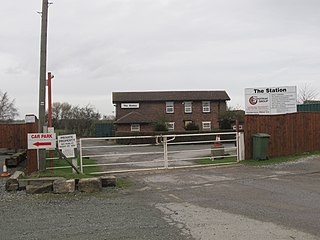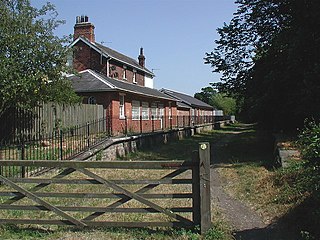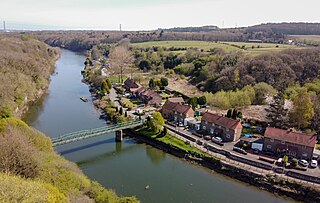
The Durham Coast Line is an approximately 39.5-mile (63.6 km) railway line running between Newcastle and Middlesbrough in North East England. Heavy rail passenger services, predominantly operated Northern Trains, and some freight services operate over the whole length of the line; it provides an important diversionary route at times when the East Coast Main Line is closed. Light rail services of the Tyne and Wear Metro's Green Line also operate over the same tracks between a junction just south of Sunderland station and Pelaw Junction.

Millfield is a Tyne and Wear Metro station, serving Sunderland Royal Hospital and the suburb of Millfield, in the City of Sunderland in Tyne and Wear, England. It joined the network on 31 March 2002, following the opening of the extension from Pelaw to South Hylton.

The Leamside Line, originally part of the Durham Junction Railway, is a disused railway line, located in the North East of England. The alignment diverges from the East Coast Main Line at Tursdale Junction, travelling a distance of 21 miles north through the Durham Coalfield and Washington, prior to joining the Durham Coast Line at Pelaw Junction. The Leamside Line closed to passenger traffic in 1964, under the Beeching cuts.

Brockley Whins is a Tyne and Wear Metro station, serving the suburbs of Boldon Colliery and Brockley Whins, South Tyneside in Tyne and Wear, England. It joined the network on 31 March 2002, following the opening of the extension from Pelaw to South Hylton.

Noel Park and Wood Green was a railway station on the Palace Gates Line in Wood Green, north London. It was located on the north-east side of The Broadway adjacent to Pelham Road. Its site is now occupied by Wood Green Shopping City.

Palace Gates railway station was on the Palace Gates Line in Wood Green, north London, on the corner of Bridge Road and Dorset Road.

Sunderland is a railway and metro station in Sunderland, Tyne and Wear, England. It is on the Durham Coast Line, which runs between Middlesbrough and Newcastle, via Hartlepool. It is owned by Network Rail and managed by Northern Trains. Since 31 March 2002, the station has also been served by the Tyne and Wear Metro's Green Line.

Whitley Bay is a Tyne and Wear Metro station, serving the coastal town of Whitley Bay, North Tyneside in Tyne and Wear, England. It joined the network on 11 August 1980, following the opening of the first phase of the network, between Haymarket and Tynemouth via Four Lane Ends.

Pallion is a Tyne and Wear Metro station, serving the suburb of Pallion, City of Sunderland in Tyne and Wear, England. It joined the network on 31 March 2002, following the opening of the Wearside extension – a project costing in the region of £100 million. The station was used by 92,060 passengers in 2017–18, making it the least-used station on the network.

Withernsea railway station is a disused railway station that was the terminus of the North Eastern Railway's Hull and Holderness Railway in Withernsea, East Riding of Yorkshire, England. It was opened by the Hull and Holderness Railway on 27 June 1854.

Patrington railway station is a disused railway station on the North Eastern Railway's Hull and Holderness Railway in Patrington, East Riding of Yorkshire, England. It was opened by the Hull and Holderness Railway on 27 June 1854. The station was closed to passengers on 19 October 1964.

Keyingham railway station is a disused railway station on the North Eastern Railway's Hull and Holderness Railway to the north of Keyingham, East Riding of Yorkshire, England. It was opened by the Hull and Holderness Railway on 27 June 1854. The station was closed to passengers on 19 October 1964.

Rye Hill and Burstwick railway station is a disused railway station on the North Eastern Railway's Hull and Holderness Railway midway between Burstwick and Ryehill in the East Riding of Yorkshire, England. It was opened by the Hull and Holderness Railway on 27 June 1854. On 1 July 1881 it was renamed to Rye Hill and on 23 September 1929 changed name again this time to Rye Hill and Burstwick. The station was closed to passengers on 19 October 1964. It is now a private residence.

Marfleet railway station is a disused railway station on the North Eastern Railway's Hull and Holderness Railway in the Marfleet area of the city of Hull in the East Riding of Yorkshire, England. It was opened by the Hull and Holderness Railway on 27 June 1854. The station was closed to passengers on 19 October 1964 and to freight on 1 May 1972.

Cox Green is a village in the Sunderland district, Tyne and Wear, England, situated on the south bank of the River Wear between Penshaw and Offerton. The village is linked to Washington Staithes on the north bank of the river, by the Cox Green Footbridge. It is primarily a residential village.

Ford Green & Smallthorne railway station is a disused railway station in Stoke-on-Trent, England.
Carlisle Canal railway station was opened in 1854 as the Carlisle terminus of the Port Carlisle Railway Company's line from Port Carlisle in Cumbria, England. That line was largely laid along the course of the Carlisle Canal, hence the station's name.

Wormald Green railway station served the village of Wormald Green, Harrogate, England from 1848 to 1964 on the Leeds-Northallerton Railway.

Newton Kyme railway station was a railway station on the former Harrogate–Church Fenton line, serving the village of Newton Kyme near Tadcaster in North Yorkshire. It handled freight and passenger traffic.

Brandon Colliery railway station served the village of Brandon, County Durham, England from 1861 to 1964 on the Durham to Bishop Auckland Line.



















